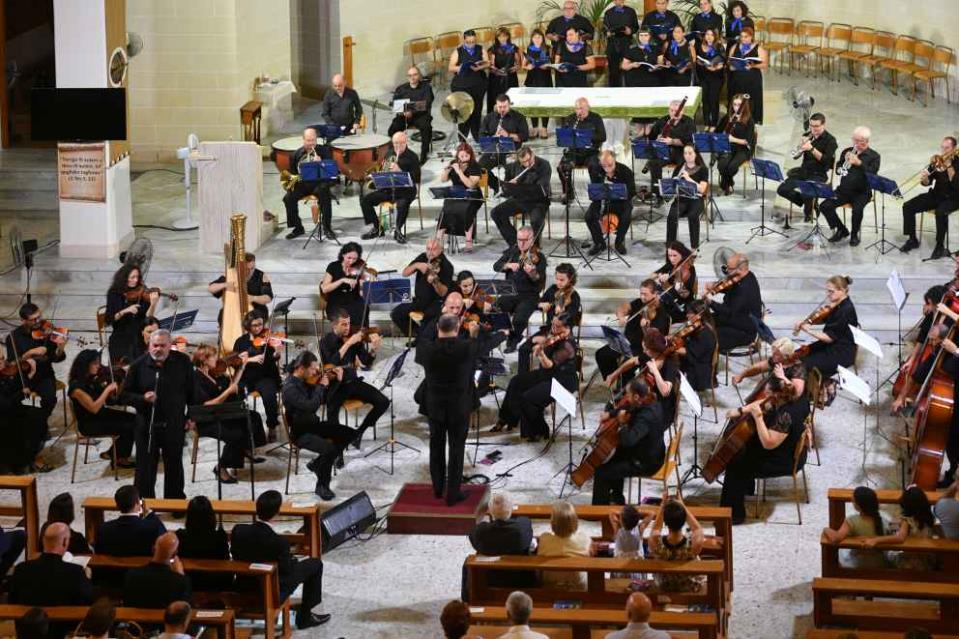The St Paul Metropolitan Orchestra will be embarking on another huge project, performing the internationally acclaimed Requiem et Resurrectio et Vita(1991) what may be considered to be one of the finest musical compositions of the sacred repertoire, composed by a 20th-century Maltese composer Mro Joseph Sammut (b.1926).
Sammut’s Requiem which was written and dedicated for the former Prime Minister of Malta Dr Giorgio Borg Olivier GCPO KSS (1911-1980)and President of La Vallette Band Club was premiered in Malta on 31 October 1991 at St John’s Co-Cathedral, Valletta.
The Requiem was recorded live during its German performance in the Parish Church of St Gebhard in Konstanz on the 11 February 1995. The premiere of the Requiem in 1991 at St John's Co-Cathedral in Valletta was heard by the German management consultant Bernd Glathe who, struck by its international message, wide vision, and musical grandiosity, made arrangements for a German performance in the university city of Konstanz, under the auspices and sponsorship of a German interest group, Music in Management. Again, and with Sammut himself conducting the Sudwestdeutsche Philharmonie Konstanz, the work was extremely well-received by the German audience.

After 28 years since its premiere, two soloists who originally performed the work in 1991, Alto Claire Massa and Tenor Joseph Aquilina will be performing the work for the second time, working together with Soprano Rosabelle Bianchi, Bass Albert Buttigieg and the St Monica Vocal Ensemble, under the baton of HE Chev Mro Mark Agius.
Requiem e Resurrectio et Vita
The sacred orchestral work, set to the traditional Latin text is specifically written for strings, woodwinds, French horns, harp, timpani and church organ, together with SATB choir and four main soloists. Although the Requiem is a through-composed orchestral work, and is roughly around 97 minutes, it comprises of 16 linked movements, namely Requiem, Dies Irae, Tuba Mirum, Liber Scriptus, Quid sum Miser, Rex Tremendae, Recordare, Ingemisco, Confutatis, Lacrymosa, Offertorio, Sanctus, Agnus Dei, Lux Aeterna, Libera Me and with an added movementResurrectio et Vita, which is normally not found in standard Requiems.
Amongst his musical output, which ranges from solo works to fully-fledged symphonic compositions, the Requiem is considered to be one of Sammut’s major orchestral works, exhibiting strong characteristics of Verdian’s operatic style that require not only professional musicians who are competent to master difficult and rigorous passages, but also to have a well-experienced conductor who is capable to fully comprehend the composer’s artistic attributes, and ultimately, to maintain constant solid report between the musicians and the soloists.

The overall harmonic organisation of the work is reminiscent of the late 19th and early 20th-century style, displaying intricate textures of post-tonality which portrays complex dissonances, but at the same time, consonance is also distinguishable. Sammut’s style of composition has led him to produce sublime lyrical melodic contours that are presented in the doubling of choir voices and woodwinds, a series of late 17th century imitative counterpoint with homophonic traits in the choir and strings’ section, artistically fused with strong accentuated melodic passages by the French horns, which ultimately, leads the work into a dimensional of sounds and textures.
In addition, Sammut’s extensive knowledge in compositional and orchestral techniques not only present us with some demanding and challenging percussive rhythmic passages, but also incorporates delicate lyrical melodies merged against sudden dramatic changes of tempo and textures that accentuates the powerful emotions engendered by the text, attained continuously within each movement that are profoundly heard and artistically mastered throughout the work.
Overall, the Requiem is a majestic orchestral work which not only displays Verdian’s solid artistic mastery in composition and orchestral technique but also, constantly maintains subtle and intricate melodies which reflect the true Puccini’s emotional sensitivity.
The Requiem e Resurrectio et Vita will be held on Friday 8th November 2019 at 7.30pm, at St Paul’s Metropolitan Cathedral, Mdina, with proceeds toId-Dar tal-Providenza.
Tickets are obtained from the Cathedral Booking Office – 21454697 or from the Orchestra Management – 79950507 or online at www.showshappening.com
By Dr Lydia Buttigieg PhD